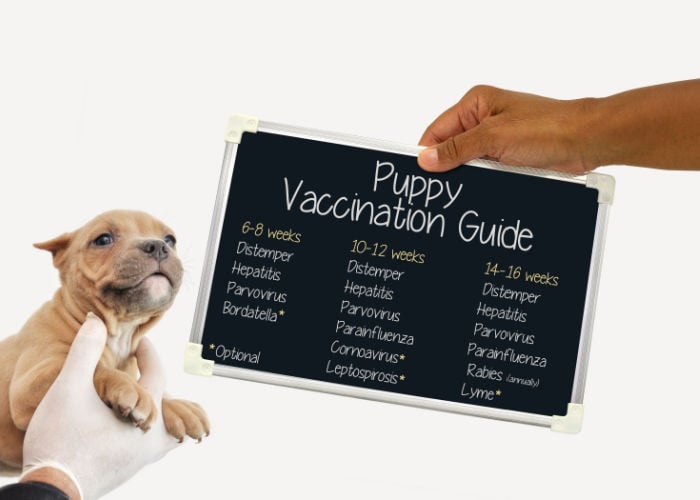
Table of Contents
Dog park diseases are something dog parents should be aware of before visiting.
More often than not, dog parks are deemed harmless and offer nothing to dogs but an enjoyable experience.
It’s like a sanctuary for our four-legged companions, where they can exercise, socialize, and play with other dog friends.
But what about the dog park dangers?
We don't realize that taking our pets to a dog park can carry various risks, including the transmission of diseases and parasites.
If taking your dog for an off-leash run is routine, we've got all the key information you need to know right here.
Read further to find out whether you have the essentials in place or if there are still gaps to fill to ensure your dog’s safety.
Are Dog Parks Good for Dogs: The Advantages
We suppose Fido doesn't have much freedom to roam about on its own if you live in an apartment, right?
A dog park is a great spot for dogs to be off-leash. They can play with other dogs and run around in a big space.
It’s also the perfect place when your pawed friend is in obedience and socializing classes.
Some dogs suffer from anxiety around people. The dog park may be a good place to desensitize your pet to meet other fur parents.
Given that everyone is at ease, encouraging them to offer your dog treats can help it become more comfortable around people.
Additionally, taking Fido to a dog park is a fantastic way to release some of its energy and ensure it gets enough exercise.
Remember, maintaining our dogs’ physical health is important. For breeds that require endurance, like German Shepherds, Collies, Pointers, and Retrievers, this is even more crucial.
But can there be dog park dangers?
Susan Nelson, DVM, clinical associate professor at Kansas State University College of Veterinary Medicine, says:
“You need to watch your dogs at the park just like you would watch your children on the playground.”
We’re here to talk about that, too. In reality, it's not all rainbows and butterflies at the dog park.
So, what could go wrong?
Are Dog Parks Bad for Dogs: The Disadvantages
Although your furry buddy may enjoy playing nicely with other canines, dog bullies are out there too.
If your dog feels uneasy in a hectic place, it can harm your bond and put them in danger.
Additionally, different dogs have different play styles that might not mesh well with your furry friend.
For example, your pup likes to play around with other tiny dogs. Its playing style is easy-going and friendly.
When your four-legged companion interacts with other huge dogs at the park, it may become fearful and defensive. That’s because it’s not into that type of play.
Did we mention that dog fights can break out too? Unsocialized dogs have the potential to attack other dogs.
Some dog parks advise you to remove your furry buddy's collar to avoid being grabbed by other dogs.
That's dangerous if you ever need to grab Fido fast during a dog fight.
In addition to dog clashes and injuries, there is another risk in dog parks that fur parents should be aware of.
Contagious diseases.
Health risks can exist even in well-maintained dog parks, particularly various infectious diseases that viruses, parasites, and bacteria may transmit.
As a matter of fact, there have been cases where dogs become sick after visiting dog parks.
We should keep in mind that this is not a myth, and there are dog park diseases that we should be wary of. Not one, not two, and not even only three.

Dog Park Diseases
Below is a list of the most frequent dog park diseases to which your canine companion may be exposed during a dog gathering.
Rabies
The rabies virus produces rabies and is 100% deadly in animals once symptoms appear.
The virus is transmitted through saliva, either through a bite from an infected animal or through saliva contaminating a cut on the skin.
Signs of furious rabies include:
- Seizures
- Extreme excitability
- Inability to eat or drink
- Hypersensitivity to light and sound
- Aggression toward people, other animals, and inanimate objects
Note that there is no treatment for a dog with rabies, according to VCA Animal Hospitals.
If rabies is suspected, the dog must be isolated and restrained from attacking someone.
Ringworm
Did you know that some breeds are more prone to ringworm?
The risk is greater for Jack Russells and Yorkshires. The likelihood of exposure may also be higher in hunting dogs and Fidos that dig in the ground.
Ringworm in dogs can appear as circular, dry, flaky, and discolored patches of skin with hair loss.
Ringworm fungi exude spores that can infect other dogs or people who share their homes with pets.
For instance, at the dog park, your four-legged friend might rub up against a dog that is infected with ringworm.
In the same manner, you can get ringworm from your dog.
Heatstroke
Dogs can experience heat exhaustion, which happens after engaging in prolonged physical activity in a hot environment without adequate hydration.
Heat stroke in dogs may occur if heat exhaustion worsens.
Our dogs often have body temperatures between 102.5 and 100 degrees Fahrenheit.
A life-threatening medical emergency requires prompt vet attention if the body temperature rises above 106.
The UA Vet Hospital encourages avoiding strenuous physical activity and keeping your dog indoors on unusually hot days.

Toxic Plants
Many different plants are extremely hazardous and even fatal to dogs. You might find any of these plants in the park nearby.
While some plants may be aesthetically beautiful, if Fido eats them when you're not looking, they could cause a whole array of problems.
The following are a few of the most typical toxic plants for your dog that can be found around our homes, in our yards, or at dog parks.
- Iris
- Tulip
- Daisy
- Azalea
- Daffodil
- Hyacinth
- Amaryllis
- Calla Lily
- Morning Glory
- Bird of Paradise
More at ASPCA's Animal Poison Control Center website.
Heartworms
Heartworm disease is a parasitic condition that can affect dogs that spend a lot of time outside. Your canine friend contracts the sickness through a mosquito bite.
This damages the heart, lungs, and arteries permanently and may have long-term effects on your dog's health and quality of life.
Signs of heartworm disease may include the following:
- Weight loss
- Decreased appetite
- Mild persistent cough
- Reluctance to exercise
- Fatigue after moderate activity
Few dogs survive if the heartworm obstruction isn't surgically removed right away.
Leptospirosis
The bacteria causing leptospirosis spread through sick animals' urine, which can get into water or soil where it survives for weeks or months.
Dogs are especially prone to leptospirosis if they play in or close to mud or puddles.
It can be contracted by your pawed pet if microbes penetrate its body through the skin or mucous membranes, especially if the skin is broken from a wound or scrape.
Drinking contaminated water might also lead to infection.
Kennel Cough
The bacterium that causes kennel cough (Bordetella bronchiseptica) is passed from infected dogs by saliva and/or aerosolized particles.
Dogs are susceptible to catching kennel cough if they visit dog parks, go to dog daycare, or undergo training lessons.
It can spread through routine dog activities like sniffing and sharing water bowls.
Kennel cough can spread through even brief contact with an infected surface, like a bush or pavement.
When your pawed friend is exposed, it typically takes two to three days before symptoms appear, but it might take up to ten days.
The most frequent indicators of canine kennel cough include:
- Gagging
- Low energy
- Decreased appetite
- Persistent hacking or honking
- Spasmodic or unproductive cough

Canine Influenza
When dogs are close to one another, the highly contagious canine influenza virus can spread throughout the immediate area.
It is an airborne illness similar to kennel cough.
In addition to being spread by touch with contaminated objects, it can also spread in droplets from a cough or sneeze.
These viruses can remain active on contaminated surfaces for up to 48 hours, and infected dogs may take up to 8 days before showing symptoms.
Fungal Infections
Blastomycosis and coccidioidomycosis are two common fungi dogs can contract by ingesting or sniffing soil.
The lungs are the main organs affected, although the infection may also extend to other organs.
Your four-legged pet breathes the fungus spores in, where they settle in the tiny airways and start to multiply.
According to MSD Veterinary Manual, the majority of affected animals exhibit the following symptoms:
- Fever
- Lethargy
- Coughing
- Weight loss
- Loss of appetite
In addition to the cough, pulmonary involvement causes your dog to become intolerant to exercise and have trouble breathing.
Canine Distemper
Dogs catch distemper from other dogs that are infected with it.
They can contract it if they come into contact with the ill dog or if they’re close to it when it’s coughing.
It is a highly transmissible virus that affects the neurological, gastrointestinal, and respiratory systems and is frequently fatal.
According to Cornell University, the mortality rate of this prevalent dog park disease is 50% for adult dogs and 80% for puppies.
Note that this is 100% preventable. That’s why it’s important to get your furry companion vaccinated as young as possible.
Canine Parvovirus
Dog parks, public parks, and other areas where dogs congregate are typical locations where Fido may come into contact with the parvovirus.
The virus, which causes the most harm to the stomach and small intestines, is classified as a disease in the Merck Veterinary Manual.
Although it is propagated through contact with contaminated feces, the virus can exist without seeing feces.
It can dwell outdoors, indoors, in kennels, or on contaminated items.
If Fido touches contaminated objects, it may also carry the disease on its fur or paws.
And to top it all off, some breeds, such as Labrador Retrievers, English Springer Spaniels, and Doberman Pinschers, are more prone to parvo than others.
External Parasites
Although these parasites are minuscule, don't let their size fool you. Particularly in puppies, severe parasite infestations can be fatal.
Fleas, lice, mites, and ticks are a few of the most prevalent parasites our dogs encounter on the outside.
Fido suffers from severe itching due to these parasites, which can dwell on top of or inside of its skin. They get advantages by obtaining nutrients at the expense of your dog.
Here are a few skin issues that your dog may experience:
- Hives
- Hair loss
- Skin redness
- Severe itching
- Pimples or bumps
- Crusting, bleeding or oozing lesions
- Excessive licking or scratching by your dog
Intestinal Parasites
Our dogs like exploring with their noses and mouths at the dog park. They might lick things, and those surfaces might contain pathogens we are unaware of.
While fleas and ticks are easy for us fur parents to spot and identify, intestinal parasites can exist inside Fido without us being aware of it
When dogs lick objects that have been contaminated with an infected animal's feces or drink contaminated water, they can eat the eggs and become infected with intestinal parasites.
Depending on the type of parasite found, there are various causes of intestinal parasites in dogs.
| Giardia |
|
| Coccidia |
|
| Tapeworm |
|
| Hookworm |
|
| Roundworm |
|
The gastrointestinal tract of our dogs is home to intestinal parasites, feeding on their nutrients and causing serious health problems.
But the good news is that they’re easy to treat and prevent.
Find out which parasite-control medicine is best for your furry buddy by consulting your vet.
Dog Park Diseases: Should I Bring My Puppy?
You should never bring your puppies under 4 months old to the dog park.
When your dog has had all of its vaccinations, usually at around 16 weeks of age, it is safe to take it to the dog park.
The advised age range is based on numerous factors, the first of which is immunization status.
Deadly viruses like parvovirus and distemper can survive for a year in the soil. Your dog can get an infection if a sick dog visits the park once in recent months.
The AAHA recommends that pups receive a course of three or more combination vaccinations every two to four weeks until they are at least 16 weeks old.
Does this indicate that after their final vaccination at 4 months old, it’s already safe to head to the dog park?
Not immediately.
You must wait at least two weeks after immunization for immunity to take effect, so don't immediately take your dog into crowded places.
In addition, puppies are impressionable in their first few months, which is another reason to hold off until they’re 16 months old.
A pack of rowdy dogs at the park might terrify your four-legged buddy and leave it with a bad memory that will stick with it into adulthood.
Therefore, they must undergo training in obedience and socialization before playing with unfamiliar dogs.
Follow this guideline to keep your dog from dog park illnesses and dangers.

Are Dog Parks Safe?
Dog park diseases can spread everywhere, especially when many dogs are around.
Let's keep things real. Not everyone picks up their dogs’ poo, and the majority of dogs definitely don't get enough deworming.
In that situation, Fido would be susceptible to infections, fleas, and worms.
In addition, we don’t know the vaccination status of every dog that attends the park. Are they protected against parvovirus and kennel cough?
If your pawed buddy is over four or five months of age, fully vaccinated, and can follow commands, then it’s probably safe.
Your pooch is more susceptible to getting sick at the dog park if it’s younger since it hasn't had enough time to build immunity to infectious diseases.
As you can see, some of the worries about dog parks are valid. But what can you do to make sure Fido is exercising safely?
You don't have to give up on the dog park.
There are safe ways to use it; we'll cover those in more detail in the next section.
Dog Park Diseases: Tips for Safer Visits
While finding a dog park is simple, ensure you know how to keep Fido safe from dog park diseases and dangers before unclipping the leash.
If you want to have a pleasant time at the dog park, remember to follow these tips.
Keep puppies at home
As previously stated, a newborn pup's immune system isn't fully developed. Therefore, contracting some infections could be fatal.
It is preferable to spend the first few months of their life socializing them with family members and other vaccinated pets inside your home.
Socialize your dog first
If your pooch isn't accustomed to a lot of bustles, being surrounded by a flurry of dogs and owners at the park can easily overwhelm it.
It's best to socialize your canine companion in a controlled setting with a small group of well-behaved dogs at first. Consider in a fenced-in backyard.
Bring dog park essentials
Poop bags and a water bowl are what we mean when we talk about “dog park essentials” to prevent dog park diseases.
As mentioned, it’s unsafe for the dogs if we don't pick up their poop since we’re unsure whether there are parasite eggs present that they could lick and swallow.
In addition, in order to avoid having to share with other dogs, make sure you bring Fido its own bowl and water. Who knows whether other dogs are suffering from kennel cough?
Teach your dog basic commands
Other fur parents won’t appreciate a dog that is uncontrollable and unruly.
Your four-legged friend needs to be able to obey orders like “sit,” “stay,” and “leave it,” especially in busy environments, to avoid dog park dangers.
Make sure vaccinations and parasite control are current
Parvovirus, influenza, and external and intestinal parasites are just a few of the dog park dangers that can be fatal or pose a major health risk to your four-legged buddy.
Ensure Fido is up to date on immunizations and parasite management for its protection and the safety of his doggie playmates.
Dog Park Diseases: FAQs
Are there diseases in dog parks?
Kennel cough is an extremely contagious infection that can be caught at dog parks. Because so many dogs congregate at dog parks, it’s easy to spread diseases.
Parvo, distemper, rabies, and other respiratory disorders are among the diseases for which your dog should be vaccinated.
Can a dog get sick at a dog park?
A dog park is a breeding ground for numerous infectious diseases that fungi, parasites, and viruses can spread.
Giardia, an intestinal parasite, is one of the main issues at public dog parks, according to Dr Kaufman. In addition to diarrhea and dehydration, it can also result in weight loss.
Can dogs get parasites from dog parks?
According to research, parasites were present in stool samples from 80% to 90% of Americans. GI parasites can affect any dog, regardless of age.
Although, associating with unfamiliar dogs can be particularly dangerous for puppies who haven't received their vaccinations.
Dog Park Diseases: Conclusion
We can minimize dog park diseases and dangers if we’re responsible and do our best to keep our dogs safe.
That includes vaccinations for our pups and ensuring they are obedient.
In this way, our dogs can enjoy what dog parks can offer as a great source of exercise to keep them happy and healthy.
If you and Fido enjoy the dog park, you might want to go during a less busy time and try building rapport with the other fur parents.
Ultimately, do your part to ensure the safety of every dog by not bringing your furry buddy to the park if it’s coughing or exhibiting other symptoms of illness.












